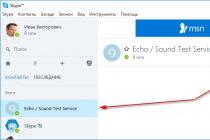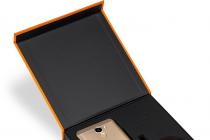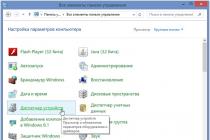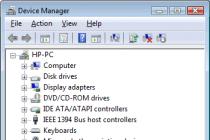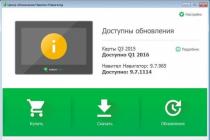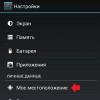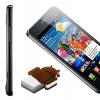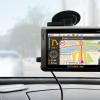27.12.2019
data hidden
GradePros: -Battery
-Design
-Fast
Cons: -Little memory
Review: The phone is good. We have been using it for more than 3 years
12/27/2019 Rating
Pros: Of course the BATTERY is 4000 - keeps on hurray. Metal and glass, and in general the design is restrained and presentable (only in blue). The assembly is also good: no creaks, no backlash. Cameras 8 and 5 are not bad for this level. A cool plastic cover, an overlay, gave the phone a nice translucent edging. Iron is not the saddest thing.
Cons: In the first months, and I bought it just in the first batches, the main camera filmed sucks (it washed), the GPS was generally inadequate. After the purchase, 2 updates came after a while, they just covered 2 of his main troubles, after the update they did not come back like that. The touchscreen is not the most sensitive, there are times when you have to press the icon twice. You cannot buy a normal cover for it, I really like the one that came in the box, but over time it broke, and the company does not sell them, but what it offers is only in the trash. There are glitches with music, it suddenly starts to deteriorate in the headphones after a long listening, when the screen is turned off. Rescues restarting the application. You can't reset everything at once running applications... Well, according to the law of meanness in the most the right time can tupanut) here, of course, maybe I have already scored applications and media, but like many androids, it is useful for him to reset to factory settings.
Review: The device is decent, I bought it with discounts in the first days of sales for 7800 rubles somewhere. There was a rich package bundle: a cover plate, normal bass headphones, a high-quality wire. Since the battery is large, and the charge goes through microUSB, it is clear that it will not charge up to 100 quickly. You bet at night, you live an active day (bluetooth is always on, geolocation and 4G, social networks, vidos and games, calls and sms), in the evening of the working day, somewhere 35 remained. And if purely calls, then there you can count on 4 days. In general, the performance is not ideal, but it will not work for a demanding person, the price and quality are respected. Would recommend to buy a year ago for sure, now there is a more interesting model.
24.09.2019
data hidden
GradePros: Performance, battery, camera,
and the screen.
Cons: After a while, some parts of the sensor began to work oddly, especially in shooters, it gets in the way.
Review: The phone is good, but the sensor does not always work well.
14.08.2018
data hidden
GradePros: At the time when the phone was bought (July 2016), almost everything was fine, most of all pleased with the battery, which lasted two days with the mobile Internet constantly on, playing games, reading books, etc. Was very convenient when traveling. The cameras were normal, the front cameras were generally good. Worked quickly, there was a minimum preinstalled apps, very rarely hung up.
Now it still holds the battery satisfactorily, although, of course, it is much worse. It loads pages relatively quickly, Multitasking also takes out, albeit slower than before.
Cons: First, I will list the shortcomings that were immediately apparent - gps worked very poorly, practically nothing, very inconvenient when there is a need to use offline maps abroad. Poorly catching wi-fi. Inconvenient keyboard. The camera did not shoot well in the evening and in bright light. Wide enough and heavy, the hand gets tired if used for a long time or in an uncomfortable position. Android has only been updated once for the entire time of use. There were almost no problems with mobile communications in the first year of use, in the second it became worse to catch Mobile Internet, hang more often. Over time, the cameras began to work worse, it became almost impossible to shoot in bright light on the main one. This is especially sad about the frontal, which was not bad. The glass cracked, and not even from a fall, but from an unsuccessful squeezing by the edge of a coin in a pocket. Well, the battery began to hold a charge two times less than the initial one. It began to heat up very quickly.
It is very difficult to choose accessories, only for Ali, and the choice is small.
Review: In general, this model did not cause strong complaints during the first year of operation - it was not buggy at all, the disadvantages did not outweigh the advantages. I took it mainly because of the battery, and expectations were met. But again, the model of this brand would not take, primarily because of the poor camera, lack of android updates and awkward bulky design.




Specifications
- Body materials: metal, glass and plastic
- Operating system: Google android 5.1
- Network: GSM / GPRS / EDGE, LTE CAT 4, two sim cards of micro format
- Processor: 4 cores, 64-bit, MediaTek MT6735
- RAM: 2 GB
- Storage memory: 16 GB
- Interfaces: Wi-Fi (b / g / n), Bluetooth 4.0, microUSB (USB 2.0) connector for charge / synchronization, 3.5 mm for a headset
- Screen: capacitive, IPS 5 "" with a resolution of 720x1280 pixels
- Camera: 8/5 MP, dual flash
- Navigation: GPS, GLONASS
- Optional: accelerometer, proximity and lighting sensors, FM radio
- Battery: non-removable, Li-Ion (Li-Ion) 4000 mAh
- Dimensions: 143x69.9x8.5 mm
- Weight: 185g
- Price: 10 990 rubles (Q2)
Introduction
The device is a pumped-up version of Power Five with one caveat: the Ice battery is not 5000 mAh, but 4000 mAh. The rest of the devices are technically very similar.
Of the interesting moments for the user, it is worth noting the presence of a fourth-generation connection, two "gigs" of RAM and the ability to charge other gadgets, that is, Power Ice acts as an external battery.
Design, dimensions, controls
The Power Ice model looks quite attractive and strict, in addition, you can choose one of two colors for the design of the gadget: either dark blue or golden. Both colors look interesting. The shape of the case is classic: a rectangle with slightly rounded corners and smooth side edges. Since the screen is dark and the bezels are completely black, it seems that the display bezel is very thin. In fact, its width is approximately 3.5 - 4 mm. However, this is also a little.




The dimensions are usual for similar gadgets with 5-inch screens - 143x69.9x8.5 mm, Ice weighs not so much “ice” - 185 grams, that is, it feels heavy. However, it fits well in the palm due to the sloping edges and relatively narrow body.


The screen is protected by Asahi glass. There is an oleophobic coating, it is of high quality, the finger glides easily. Of course, the glass collects fingerprints, but they are erased without problems.
The sides are plastic. The thin edging is semi-gloss, and the thick edging is chrome-plated. The back cover is made partly of plastic: the upper and lower inserts, as well as the side edges, are made of this material. The metal is not felt in the hand.







On top of the front panel there are light and proximity sensors, a camera and a speaker. The speaker has a slightly higher volume than average, the intelligibility is excellent, the interlocutor can be heard clearly, there are no echoes and other third-party sounds.
Below the display - "Menu", "Home" and "Back". There is no backlight, invisible in the dark.
The microUSB connector and microphone are on the bottom, and on the top is a lone 3.5 mm audio output.
On the right are the metal power button and volume rocker.
On the back there are: a recessed camera, a flash and a speaker.


The cover is removed rather tightly, but the assembly is excellent. Under the panel on top there are two slots for microSIM and a microSD slot.

Highscreen Power Ice (left) and Power Rage

Highscreen Power Ice (left) and Power Four

Highscreen Power Ice (left) and Boost 3
Display
This device uses a 5-inch screen. The physical size is 62x110 mm, the frame at the top is 16 mm, at the bottom - 16.5 mm, on the right and left - about 3.5-4 mm each. There is an anti-reflective coating, which is quite effective.
The resolution of the Power Ice display from Highscreen is HD, that is, 720x1280 pixels, the aspect ratio is 16: 9, the density is 293 pixels per inch. IPS matrix without air gap.
The maximum white brightness is 380 cd / m2, the maximum black brightness is 0.4 cd / m2, the contrast is 760: 1.
The color rendition is pleasant, however, the white color is slightly shifted to warm shades, the picture is slightly violet at the corners. On the whole, the screen is normal, the brightness is disappointing - it is extremely low, the image is not readable in the sun.










Viewing angles

Battery
This model uses a 4000 mAh non-removable lithium-ion (Li-Ion) battery.
In my mode of working with the device, the gadget functioned for 3 days: an hour of calls, constant synchronization with Wi-Fi (every day from 9.00 to 01.00, Twitter, mail, Skype, Whatsapp), 4-6 hours of LTE. The screen glow in this mode is 4 hours.
If you turn off all power saving functions and use the screen for about 6 hours, then the device will sit down on about the third day.
With a minimum load, you can achieve 8 hours of luminescence of the screen at 100% brightness of the matrix backlight. With games, the situation is a little worse: the battery runs out after 6-7 hours of continuous "battle". The video device "spins" for about 10 hours (HD).
In the kit you will find network adapter 1 A. So it will take a long time to charge the battery - 4-5 hours.

From the original: Power Ice can charge other devices. The output current is about 1 A. Unfortunately, there was no special adapter included in the kit.
Communication capabilities
The device works not only in 2G / 3G networks, but also in 4G CAT 4:
- GSM / GPRS / EDGE (900/1800/1900 MHz);
- 3G / HSPA + (900/1900/2100 MHz);
- 4G / LTE (1/3/7/20)



There is no NFC chip, the rest is standard for any Android smartphone: GPS and GLONASS, Wi-Fi b / g / n, Bluetooth 4.0, USB 2.0 with OTG support.
Memory and memory card
It costs 2 GB inside random access memory, usually about 1300 MB free.


Built-in memory 16 GB, about 10 GB available. There is a slot for a microSD memory card, the maximum volume is 64 GB.
Cameras
Traditionally, there are two camera modules: 8 MP (six-lens optics with Blue Glass filter, F2.2 aperture) and 5 MP (F2.8 aperture). There is one LED flash.
It uses modules similar to Power Five. Therefore, I will allow myself to quote myself:
“When I first saw the resolution of the main camera in performance characteristics, I was surprised, to put it mildly. Now almost everyone modern devices v price category from 10,000 rubles and above, as a rule, they are equipped with a 13 MP camera.
In practice, it turned out that the developers decided not to dissemble and put an "honest" 8 MP module, and not a camera with a supposedly 13 MP matrix. I liked the quality of the Highscreen Power Five camera: excellent detail, a small amount of noise even when shooting in poor lighting conditions, accurate white balance. Since I use an iPhone 5, it seemed to me that Highscreen has the same camera module as Apple, at least the nature of noise, color rendition and other parameters correspond.
The front camera shoots great. The angle is not very wide, but the face is not distorted either.
The main camera records video in FullHD resolution at 27 fps ( good lighting) and at 16 fps (insufficient lighting conditions). The picture is not wide-angle, the clarity is good, there is little noise. Cons - focus is very slow and inaccurate. The sound is of average quality. The front camera is HD 30 fps during the day and 16 fps at night. "
Unlike Power Five, Four, and Rage, Ice has manual settings shutter speed, ISO value, focus, white balance. The mode is called "Pro".











Sample photos
Performance
The device is powered by the Taiwanese MediaTek MT6735 chipset. It is a 64-bit SoC that contains 4 ARM Cortex-53 cores, 28nm process technology, clock frequency each - up to 1.5 GHz. Mali T-720 with support for Open GL ES 3.0 and Open CL 1.2 API is used as graphics.
Under the load of the processor, the case practically does not heat up.
If we talk about software optimization, then in Highscreen everything is fine with this: the interface works smoothly, without any hints of brakes, applications start quickly. With toys, too, everything is more or less normal, but you should not count on the maximum parameters and 60 FPS: for example, in Unkilled you have to set the settings to medium or even low, Brothers In Arms 3 also slows down.
It should be noted that the MT6735 chip was created as an inexpensive solution for use in devices that can function in various networks. Therefore, its main feature is LTE in our country.
Performance tests













And therefore, first of all, we naturally wanted to test the killer feature declared by the manufacturer. Have you ever seen how one smartphone charges another smartphone?
To implement this functionality, an OTG adapter was included in the Power Ice kit, and the smartphone itself was equipped with a non-removable 4000 mAh lithium-polymer battery. This is not to say that charging is fast, but it damn well happens! The fill rate of the donor smartphone battery strip is comparable to a standard adapter charging with an output current of 1 A.

The Power Ice's own battery life is quite consistent with the battery capacity. To discharge it in a day, it took us many hours of non-stop online video playback at maximum screen brightness. This scenario of using a mobile is not very applicable to real life, and in the standard mode of operation - browsing, instant messengers and the like - the smartphone loses no more than 35-40% of the charge per day.
When talking about the capacity of the battery, the dimensions of the Power Ice should also be taken into account. Still, this is not a chubby phablet shovel, but a completely standard 5-inch smartphone by modern standards, and quite thin. The case is only 8.5 millimeters thick, and Highscreen engineers have managed to fit everything you need into them.
 ‘
‘


The Power Ice filling is not top-notch, but it can handle all current applications and not too demanding games. Inside the smartphone is a 4-core MediaTek MT6735, Mali T-720 graphics, 2 GB of RAM and 16 GB expandable storage via a microSD slot.
Power Ice is a two-symbol. 4G support is available, and given the manufacturer's focus on Russian market, worry about the support of certain LTE frequencies is not necessary at all. Other types of communication: Wi-Fi b / g / n, Bluetooth 4.0, GPS, GLONASS.
If you remember about the price of the device, then the constant expectation of a trick does not come out of my head. Well, what did the manufacturer save the most on? In fact, Power Ice has no frankly weak points, and the seemingly underestimated individual characteristics are compensated by other technological bells and whistles. For example, the main camera with a resolution of only 8 megapixels. Few? Perhaps, if you are going to closely engage in smartphone photography, but here is a pretty decent 6-lens optics with a smart filter that allows you to get better pictures in unfavorable lighting.
There are no complaints about the front camera at all. 5MP is more than enough for both selfies and video calls.
Power Ice's screen is not Full HD, but IPS. With a diagonal of 5 inches and a resolution of 1,280 × 720, the ppi index is still close to Retina, and you will hardly be able to see the pixels on the screen at the standard distance of the smartphone from the eyes.

The operating system is almost unchanged stock Android 5.1 Lollipop.

At the end of this short review, I would like to return once again to the Power Ice case and note the quality and materials of its execution. Fortunately, gone are the days when the budget of the smartphone was achieved by using the cheapest nasty plastic in combination with frankly no assembly. In this case, everything is in order with the case.

The back panel of Power Ice is made of metal, the front panel is completely covered with scratch-resistant glass. Most likely, it is Gorilla Glass 3. The smartphone fits well in the hand, when you try to squeeze it, there is no creak or backlash. The buttons fit exactly and don't dangle.
Not so long ago, Lifehacker came out, claiming that modern smartphone shouldn't cost more than $ 100. If we consider that the price of Highscreen Power Ice is only $ 19 higher than the "standard", but the device itself has quite impressive characteristics and a unique function of charging other devices, it turns out quite decent smartphone no overpayment for a well-known brand. What do you think?
How difficult it is to find a smartphone in an attractive case with good performance for little money! Russian company Highscreen introduced new model in thin metal case, with a capacious battery and good filling. Having seen Highscreen Power Ice for the first time, I can't believe that this is a state employee.
Specifications and performance
- Quad-core MediaTek processor MT6735 @ 1.3 GHz;
- Mali-T720 as a video accelerator;
- OS Android version 5.1;
- 2 GB of RAM and 16 GB of internal memory;
- slot for microSDHC memory cards;
- support for two SIM;
- GPS navigation;
- capacity battery 4000 mAh.
As you can see, the filling is not weak. Of course, this is not top-end hardware, and it will not work to drive resource-intensive games on it. But the device copes with other tasks easily. Video playback, browsing heavy sites, mediocre games - it's all easy with Highscreen Power Ice.
Appearance
The design of the novelty can be called exemplary for budget smartphone... No logos and shiny things, everything is strict and laconic. The device is presented in two colors: graphite blue and gold.
A thin plastic edge runs along the perimeter of the front surface, which protrudes a millimeter above the glass, which is a good protection against scratches. Laconic style back cover the smartphone is diluted only by the large Highscreen logo in the center.
The weight of the smartphone is 180 grams, it gives solidity to the gadget. The combination of considerable weight, metal and compact size gives the feeling of a reliable and durable thing.

Screen
The five-inch screen received a resolution of 1280x720 pixels, which provides a fairly high pixel density. There can be no claims to the detail of the image. The matrix of the smartphone guarantees correct color reproduction and very wide viewing angles. The impressive range of backlight brightness is also pleasing. The screen is protected by Asahi Glass Dragontrail without an air gap. The sensitive sensor recognizes up to five simultaneous touches.

Camera
The main camera of the device received an 8-megapixel matrix with autofocus optics and LED flash. A smart application with a user-friendly interface and many useful functions... There are also a variety of shooting modes, including the imposition of all kinds of effects and HDR. The main camera produces good results. On a clear day, there can be no complaints about the quality of the pictures. With a lack of light, the quality is lower, noise appears, and the white color turns into green.
The front 5-megapixel camera provides a decent level of detail, which is enough for regular selfies.
Outcomes
It turned out to be a well-balanced product, it really can be called an ideal budget employee. The device has plenty of advantages, but the critical shortcomings are at a minimum. Highscreen Power Ice is available for $ 120.
Highscreen Power Ice video review
Information about the brand, model and alternative names of a specific device, if any.
Design
Information about the dimensions and weight of the device, presented in different units of measurement. Used materials, offered colors, certificates.
| Width Width information - refers to the horizontal side of the device in its standard orientation during use. | 69.9 mm (millimeters) 6.99 cm (centimeters) 0.23 ft (feet) 2.75 in (inches) |
| Height Height information - refers to the vertical side of the device in its standard orientation during use. | 143 mm (millimeters) 14.3 cm (centimeters) 0.47 ft (feet) 5.63 in (inches) |
| Thickness Information about the thickness of the device in different units measurements. | 8.5 mm (millimeters) 0.85 cm (centimeters) 0.03 ft (feet) 0.33 in (inches) |
| Weight Information about the weight of the device in different units of measurement. | 185 g (grams) 0.41 lbs (pounds) 6.53 oz (ounces) |
| Volume The approximate volume of the device, calculated based on the dimensions provided by the manufacturer. Refers to devices with a rectangular parallelepiped shape. | 84.96 cm³ (cubic centimeters) 5.16 in³ (cubic inches) |
| Colors Information about the colors in which this device is offered for sale. | Golden Blue |
| Materials for the manufacture of the case Materials used for the manufacture of the device body. | Metal |
SIM card
A SIM card is used in mobile devices to store data that certifies the authenticity of mobile service subscribers.
Mobile networks
A mobile network is a radio system that allows multiple mobile devices to communicate with each other.
| Gsm GSM (Global System for Mobile Communications) is designed to replace the analog mobile network (1G). For this reason, GSM is often referred to as a 2G mobile network. It is enhanced by the addition of GPRS (General Packet Radio Services) and later EDGE (Enhanced Data rates for GSM Evolution) technologies. | GSM 900 MHz GSM 1800 MHz GSM 1900 MHz |
| UMTS UMTS stands for Universal Mobile Telecommunications System. It is based on the GSM standard and refers to 3G mobile networks. Developed by 3GPP and its biggest advantage is to provide more speed and spectral efficiency thanks to W-CDMA technology. | UMTS 900 MHz UMTS 1900 MHz UMTS 2100 MHz |
| LTE LTE (Long Term Evolution) is defined as a fourth generation (4G) technology. It is developed by 3GPP based on GSM / EDGE and UMTS / HSPA with the aim of increasing the capacity and speed of wireless mobile networks. The subsequent development of technologies is called LTE Advanced. | LTE 800 MHz LTE 1800 MHz LTE 2100 MHz LTE 2600 MHz |
Mobile technology and data rates
Communication between devices in mobile networks is carried out using technologies that provide different data transfer rates.
Operating system
An operating system is the system software that controls and coordinates the operation of hardware components in a device.
SoC (System on Chip)
A system on a chip (SoC) integrates all the major hardware components of a mobile device into a single chip.
| SoC (System on Chip) A system on a chip (SoC) integrates various hardware components such as a processor, graphics processor, memory, peripherals, interfaces, etc., as well as the software required for their operation. | MediaTek MT6735 |
| Technological process Information about the technological process by which the chip is manufactured. The value in nanometers is half the distance between the elements in the processor. | 28 nm (nanometers) |
| Processor (CPU) The main function of the processor (CPU) of a mobile device is to interpret and execute instructions contained in software applications. | ARM Cortex-A53 |
| Processor size The capacity (bits) of the processor is determined by the size (in bits) of registers, address buses and buses for data. 64-bit processors offer better performance than 32-bit processors, which in turn are more efficient than 16-bit processors. | 64 bit |
| Instruction set architecture Instructions are commands with which the software sets / controls the processor. Information about the instruction set (ISA) that the processor can execute. | ARMv8-A |
| Level 1 cache (L1) The cache memory is used by the processor to reduce the time it takes to access more frequently used data and instructions. L1 (level 1) cache is small and much faster than both system memory and other levels of cache. If the processor does not find the requested data in L1, it continues to look for it in the L2 cache. On some processors, this search is performed simultaneously in L1 and L2. | 32 KB + 32 KB (kilobytes) |
| L2 cache L2 (level 2) cache is slower than L1, but instead has a larger capacity to cache more data. It, like L1, is much faster than system memory (RAM). If the processor does not find the requested data in L2, it continues to look for them in L3 cache memory (if available) or in RAM memory. | 512 KB (kilobytes) 0.5 MB (megabytes) |
| Number of processor cores The processor core executes program instructions. There are processors with one, two or more cores. Having more cores increases performance by allowing multiple instructions to execute in parallel. | 4 |
| CPU clock speed The clock speed of a processor describes its speed in cycles per second. It is measured in megahertz (MHz) or gigahertz (GHz). | 1300 MHz (megahertz) |
| Graphics processing unit (GPU) A graphics processing unit (GPU) handles computation for a variety of 2D / 3D graphics applications... V mobile devices ah, it is used most often by games, consumer interface, video applications, and more. | ARM Mali-T720 MP1 |
| Number of cores GPU Like a processor, a GPU is made up of several working parts called cores. They handle the graphical computation of various applications. | 1 |
| GPU clock speed Speed is the clock speed of the GPU and is measured in megahertz (MHz) or gigahertz (GHz). | 600 MHz (megahertz) |
| The amount of random access memory (RAM) Random access memory (RAM) used operating system and all installed applications. The data that is saved in the RAM is lost after the device is turned off or restarted. | 2 GB (gigabytes) |
| Memory type (RAM) Information about the type of random access memory (RAM) used by the device. | LPDDR3 |
| Number of RAM channels Information about the number of RAM channels which are integrated into the SoC. More channels means more high speeds data transmission. | Single channel |
| RAM frequency The frequency of the RAM determines its speed of operation, more specifically, the speed of reading / writing data. | 640 MHz (megahertz) |
Built-in memory
Each mobile device has built-in (non-removable) fixed memory.
Memory cards
Memory cards are used in mobile devices to increase the storage space for data.
Screen
The screen of a mobile device is characterized by its technology, resolution, pixel density, diagonal length, color depth, etc.
| Type / technology One of the main characteristics of the screen is the technology by which it is made and on which the image quality of information directly depends. | IPS |
| Diagonal On mobile devices, screen size is expressed in terms of the length of its diagonal, measured in inches. | 5 in (inches) 127 mm (millimeters) 12.7 cm (centimeters) |
| Width Approximate screen width | 2.45 in (inches) 62.26 mm (millimeters) 6.23 cm (centimeters) |
| Height Approximate screen height | 4.36 in (inches) 110.69 mm (millimeters) 11.07 cm (centimeters) |
| Aspect ratio The aspect ratio of the long side of the screen to its short side | 1.778:1 16:9 |
| Permission Screen resolution shows the number of pixels horizontally and vertically on the screen. More a high resolution means sharper image detail. | 720 x 1280 pixels |
| Pixel density Information about the number of pixels per centimeter or inch of the screen. Higher density allows information to be shown on the screen in clearer detail. | 294 ppi (pixels per inch) 115 ppcm (pixels per centimeter) |
| Color depth Screen color depth reflects the total number of bits used for color components in one pixel. Information about the maximum number of colors the screen can display. | 24 bit 16777216 flowers |
| Screen footprint The approximate percentage of the display area on the front of the device. | 69.17% (percent) |
| Other characteristics Information about other functions and features of the screen. | Capacitive Multitouch |
Sensors
Different sensors perform different quantitative measurements and convert physical metrics into signals that can be recognized by the mobile device.
Rear camera
The main camera of a mobile device is usually located on its rear panel and can be combined with one or more additional cameras.
| Sensor type Information about the type of camera sensor. Some of the most widely used sensor types in mobile cameras are CMOS, BSI, ISOCELL, and others. | CMOS (complementary metal-oxide semiconductor) |
| Light-strength | f / 2.4 |
| Focal length | 2.9 mm (millimeters) |
| Number of optical elements (lenses) Information about the number of optical elements (lenses) of the camera. | 6 |
| Flash type The rear (rear) cameras of mobile devices mainly use LED flashes. They can be configured with one, two or more light sources and vary in shape. | LED |
| Image Resolution | 3264 x 2448 pixels 7.99 MP (megapixels) |
| Video resolution Information about the maximum video resolution that the camera can record. | 1920 x 1080 pixels 2.07 MP (megapixels) |
| Video recording rate (frame rate) Information about the maximum recording rate (frames per second, fps) supported by the camera at maximum resolution. Some of the most basic video recording speeds are 24 fps, 25 fps, 30 fps, 60 fps. | 30 frames / sec (frames per second) |
| Specifications Information about additional software and hardware features of the rear (rear) camera. | Autofocus Burst shooting Digital zoom Digital image stabilization Geographic tags Panoramic shooting HDR shooting Touch focus Face recognition Adjusting the white balance ISO setting Exposure compensation Self-timer Scene selection mode |
| Blue filter glass |
Front-camera
Smartphones have one or more front cameras of different designs - pop-up camera, PTZ camera, notch or hole in the display, camera under the display.
| Light-strength Aperture (also known as aperture, aperture, or f-number) is a measure of the size of the lens aperture, which determines the amount of light entering the sensor. The lower the f-number, the larger the aperture and the more light reaches the sensor. Usually, the f-number is indicated, which corresponds to the largest possible aperture of the aperture. | f / 2.2 |
| Focal length The focal length indicates the distance in millimeters from the sensor to the optical center of the lens. Equivalent focal length (35mm) is the focal length of a mobile device camera, equated to the focal length of a 35mm full-frame sensor, at which the same angle of view will be achieved. It is calculated by multiplying the real focal length of the mobile device camera by the crop factor of its sensor. The crop factor can be defined as the ratio between the diagonals of a 35mm full-size sensor and a mobile device sensor. | 1.9 mm (millimeters) |
| Image Resolution Resolution is one of the main characteristics of cameras. It represents the number of horizontal and vertical pixels in the image. For convenience, smartphone manufacturers often quote resolutions in megapixels, indicating the approximate number of pixels in millions. | 2560 x 1920 pixels 4.92 MP (megapixels) |
Audio
Information about the type of speakers and audio technology supported by the device.
Radio
The radio of the mobile device is a built-in FM receiver.
Locating
Information about the navigation and positioning technologies supported by the device.
Wi-Fi
Wi-Fi is a technology that enables wireless communication for transferring data over short distances between various devices.
Bluetooth
Bluetooth is a standard for secure wireless transfer of data between different types of devices over short distances.
USB
USB (Universal Serial Bus) is an industry standard that allows different electronic devices to exchange data.
Headphone jack
This is an audio connector, which is also called an audio connector. The most widely used standard in mobile devices is the 3.5mm headphone jack.
Connecting devices
Information about other important connection technologies supported by the device.
Browser
A web browser is a software application for accessing and viewing information on the Internet.
Video file formats / codecs
Mobile devices support different video file formats and codecs, which respectively store and encode / decode digital video data.
Battery
Mobile device batteries differ in their capacity and technology. They provide the electrical charge required for their function.
| Capacity Battery capacity indicates the maximum charge it can store, measured in milliampere-hours. | 4000 mAh (milliampere-hours) |
| A type The type of battery is determined by its structure and, more precisely, by the chemicals used. Exists different types lithium-ion and lithium-ion-polymer batteries are most commonly used in mobile devices. | Li-polymer |
| Standby time 2G Standby time in 2G is the period of time during which the battery charge is completely discharged when the device is in stand-by mode and connected to a 2G network. | 360 h (hours) 21600 min (minutes) 15 days |
| 3G standby time Standby time in 3G is the period of time during which the battery is completely discharged when the device is in stand-by mode and connected to a 3G network. | 360 h (hours) 21600 min (minutes) 15 days |
| Specifications Information about some additional characteristics of the device's battery. | Non-removable |


